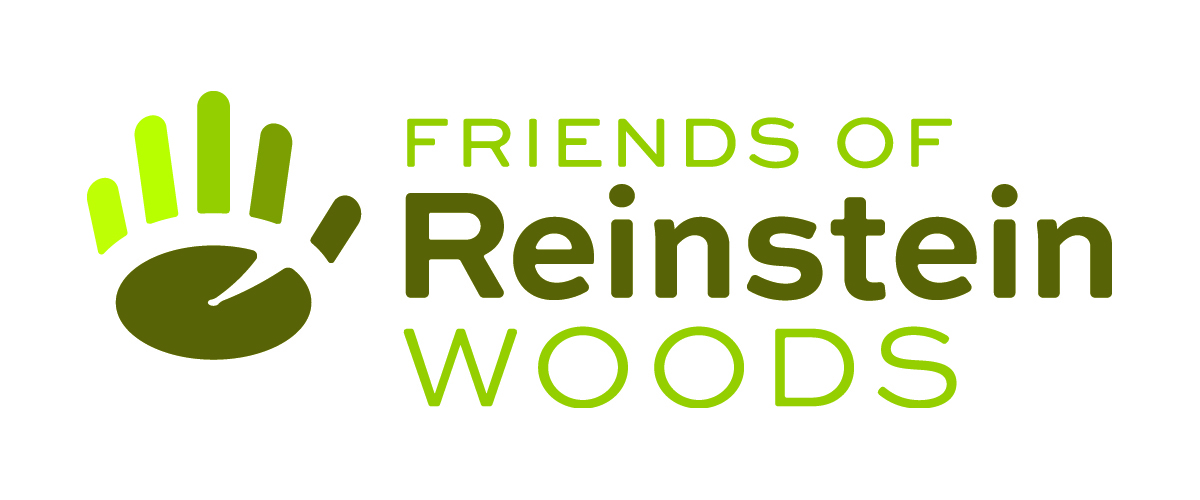Tag Archives: NYS Department of Environmental Conservation
National EE Week Part 5: Climate Changes

I admit it: I hate heat. I hate hot weather the way many people hate snow. I’d rather throw on an extra layer than sweat through a 90 degree day.
Like it or not, our planet is getting warmer, and that is changing the climate- the general pattern of weather upon which our food and water sources depend. The thought of it can be overwhelming, enough to make you sweat even in winter.
While we can’t change what’s already happened, we can change our behavior to affect the climate of the future. The most important thing we can do is make our voices heard to those in a position to create policies that will have a positive long term effect. Beyond that, try a few small actions in honor of Earth Day 2016:
Turn it off. Look around right now. How many lights are on that aren’t really being used? What about a TV? Lighting can be more than 10 percent of your electric bill, while the fossil-fueled power plants that provide the electricity are adding to the planet’s warming. Get in the habit of turning lights and other electronics off. Everywhere you go- does that TV really need to be on in the empty waiting room?
Plant a Tree or Native Plant. Trees take one of the main climate change culprits, carbon dioxide, out of the air. So planting one helps. How do native plants help? Come to Lyn Chimera’s talk on May 22 and find out.
Recycle. Do you throw things out at work that you’d put in a recycling bin at home? Could you bring them home? If you aren’t sure what to put in a bin, check out the City of Buffalo’s guide– just type in an item and it will tell you if it’s recyclable. Remember Reinstein Woods accepts:
- sneakers for reuse,
- used clothing and bedding for reuse or recycling for Hearts for the Homeless
- hair care, skin care, and cosmetic product packaging through Terracycle.
Volunteer. On May 7, volunteers will gather at Reinstein Woods to remove invasive species, plant native plants, and even search for geocaches while picking up trash at Earth Day in May. If you can’t make it to Reinstein Woods that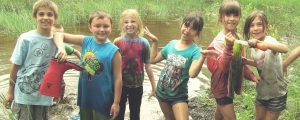 day, check out the I Love My Park Day website to find a park near you and volunteer.
day, check out the I Love My Park Day website to find a park near you and volunteer.
Get Out. A growing body of evidence suggests that kids who spend time outside are happier, healthier and do better in school than kids that don’t. Bonus: they are far more likely to grow up to support environmental causes, which is good for the future climate. To help a kid experience the outdoors, you can donate to Friends of Reinstein in support of scholarships for the Kids in the Woods Summer Day Camp or the Pat Taeger Field Trip Fund. For more info, call (716) 683-5959 or email info@reinsteinwoods.org.
And get outside today too- it may not be hot, but you will feel happier and healthier too!
National EE Week Part 3: Turtles!
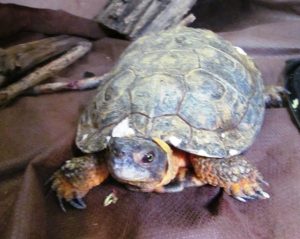
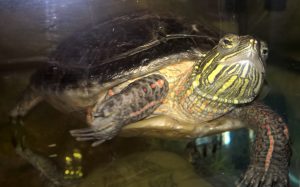
Meet Clementine and Clover, Reinstein Woods’ newest permanent residents! After their owner passed away, these turtles were found under a rug in a home in Clarence. Because both of these turtles are native to New York State, it is illegal to possess them without a permit. Because they had been living in captivity for an unknown period of time, it was not safe to release them into the wild. Thus Reinstein Woods adopted them to serve as ambassadors for their species.
Clover is a female painted turtle. (To identify the sex of a turtle, look at the shape of the bottom shell—flat for females; concave for males).
Named for the yellow and red markings on their head, legs and edge of their shell, painted turtles are the most common turtle at Reinstein Woods. The lower shell of Clover has a dark central blotch, which indicates she is a subspecies called the Midland painted turtle. (The Eastern painted turtle has no mark).
On a walk through Reinstein Woods, look for “shiny black rocks” on logs laying in Lily Pond and Green Heron Pond. Those “rocks” are actually painted turtles basking in the sun. Sometimes the turtles will stack right on top of each other!
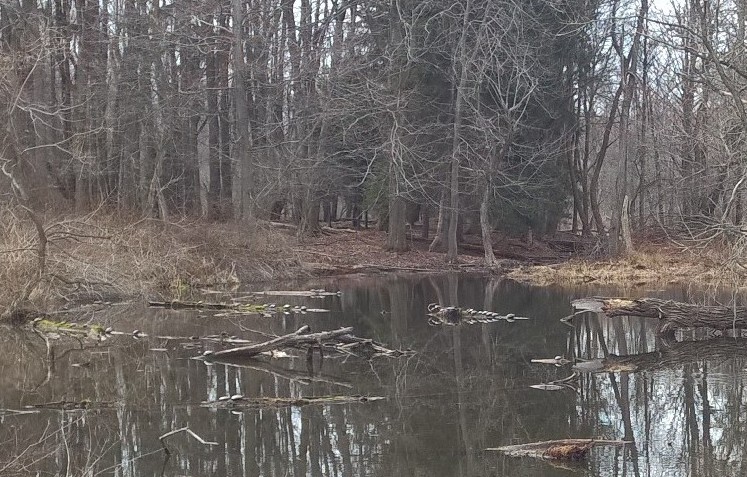
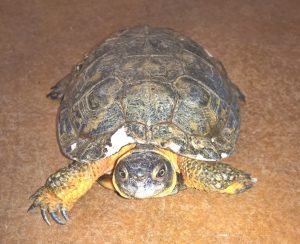
Clementine is a wood turtle. Wood turtles take their name from their preferred woodland habitat, as well as the prominent rings (annuli) on their back that remind some of wood. These colorful turtles spend most of their time wandering the woods along the edge of streams, searching for berries, mushrooms, insects, worms, and small aquatic creatures to eat.
Wood turtles are a Species of Special Concern in New York State. “Special Concern” means an animal could become threatened or endangered in the future due to several factors. In the case of wood turtles, habitat destruction is a major concern. Records from the herp atlas, an effort to identify where reptiles and amphibians live in New York State, indicate that wood turtles are uncommon in most of Western New York, but have a broader distribution downstate. To learn about efforts to help wood turtles deal with habitat disturbance downstate, check out the “Tiny Turtle Bridges” video from NPR’s Science Friday.
And be sure to stop by the Reinstein Woods’ classroom to meet Clementine and Clover on your next visit to Reinstein Woods!
National EE Week Part 2: Nature’s Engineers
A spider, a beaver and a caddisfly walk into a bar….
It sounds like the start of a bad joke, but these animals do actually have something in common: they all are incredible builders, capable of making amazing homes for themselves.
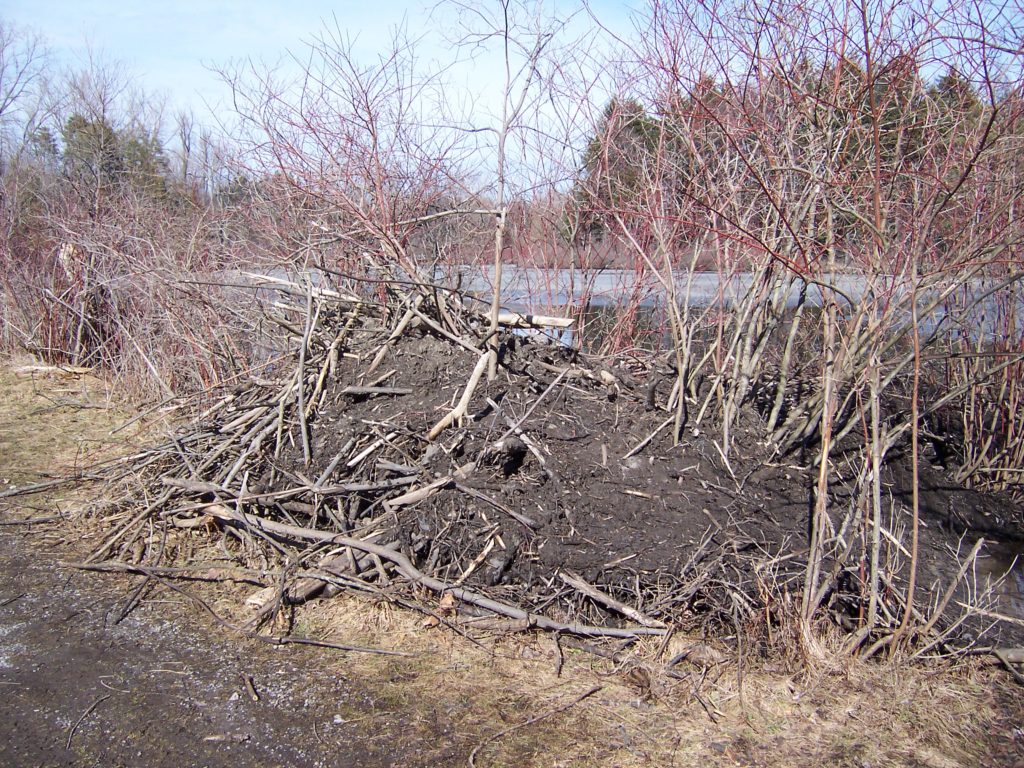
The beaver lodge at Reinstein Woods is one of the most popular stops on a trip around the Lily Pond. This pile of sticks and mud may appear random, but the beavers know how to build a house that provides them with protection from predators and the weather- even in the deepest winter, it provides both a constant temperature and adequate ventilation to sustain the life inside. 
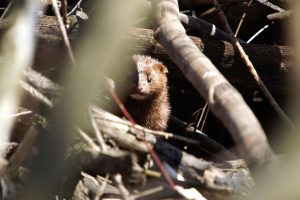
The lodge provides habitat not just for beaver, but also for other animals: snakes can often be found basking in the sun atop the lodge; Canada geese may nest on top of it, and mink are frequent visitors.
More important than their lodge home, the dams built by beavers create wetlands that sustain a variety of wildlife, making them one of only three species that can create completely new habitats capable of sustaining a variety of organisms (can you name the other two?).
You can explore the woods and learn about some of the other master builders (including spiders and caddisflies) living in Reinstein Woods at “Nature’s Engineers,” a walk and talk at 10:30 a.m. on Saturday, April 23. To register, call (716) 683-5959.
National EE Week Part 1: Scavengers!
Happy National Environmental Education Week! Reinstein Woods is excited to be part of this national effort that encourages and celebrates environmental learning across the United States. To celebrate, this week we’ll be highlighting some interesting nature sightings and activities at Reinstein Woods!
Recently a deer passed away in Reinstein Woods, we think after being hit by a car. Since in nature everyone is someone else’s lunch, we were curious who would visit the carcass. Naturalist Intern Heather Rutherford mounted a trail camera at the site of the carcass and recorded the visitors over four days in early March. The camera revealed visitors that you are likely to see on a stroll through Reinstein Woods, and also more reclusive creatures that call Reinstein Woods home.
The first visitor was a red-tailed hawk. The most common hawk in New York State, the red-tailed hawk is often seen sitting on telephone posts along roads, searching for small mammals in the grass below. This raptor will take advantage of carrion like this fresh deer. 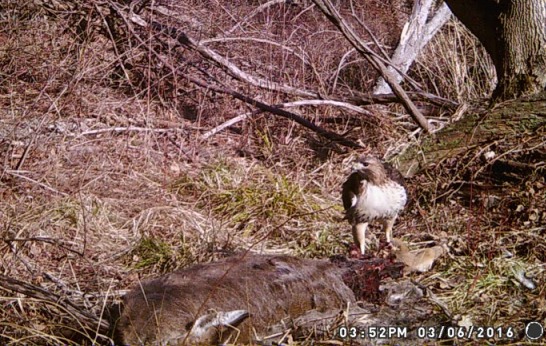
This or a different hawk visited the carcass on each of three successive days, showing off the red tail that gives it its name. 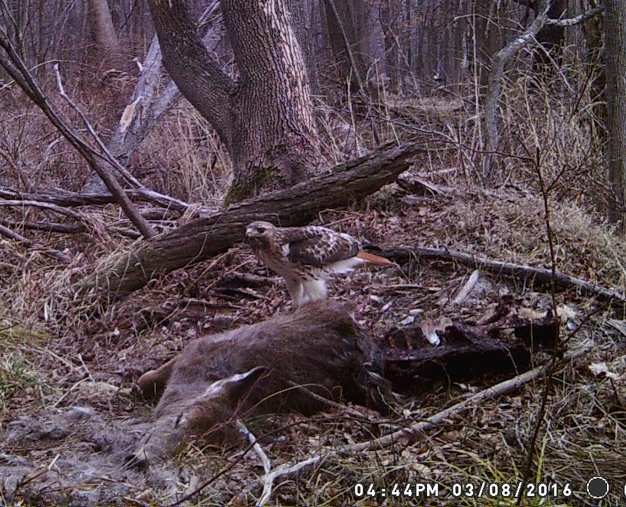
The next visitor was a white-tailed deer who may have wandered in out of curiosity, or just by chance.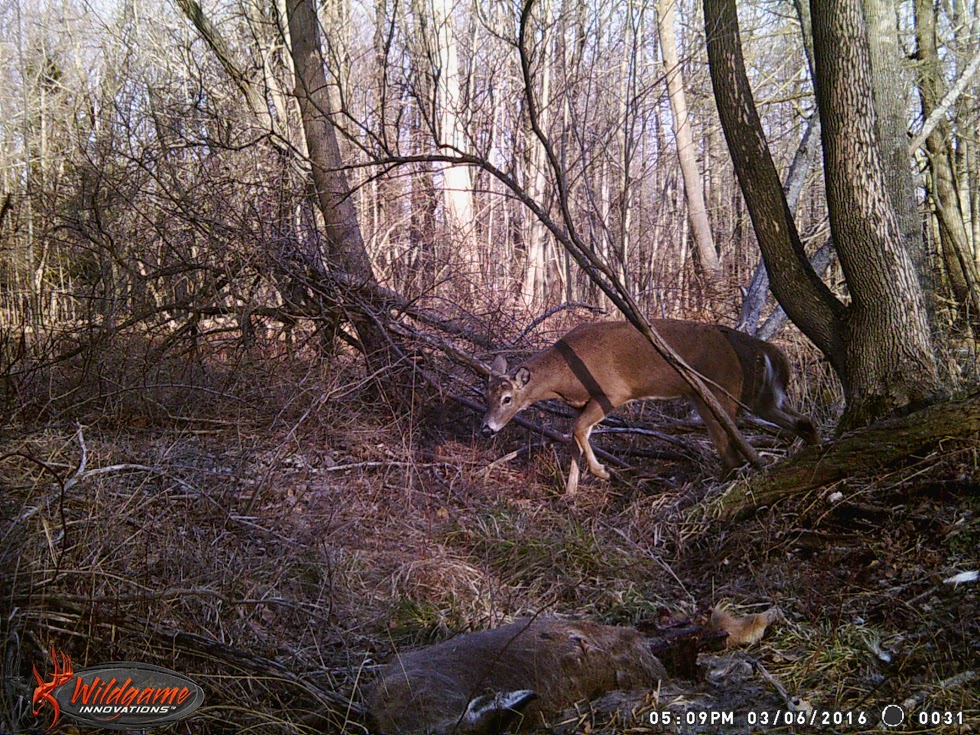 While white-tailed deer are most active at dawn and dusk, their abundant local population makes them a frequent sighting on walks through Reinstein Woods.
While white-tailed deer are most active at dawn and dusk, their abundant local population makes them a frequent sighting on walks through Reinstein Woods.
Within a couple of hours, a coyote appeared on camera. These much misunderstood animals live at Reinstein Woods but are seldom seen. They will scavenge on deer carcasses but don’t often kill adult deer, preferring instead to hunt for smaller animals like rabbits, mice, voles, and other small mammals. They will eat insects and berries at certain times of year as well. (Humans are not on their list of preferred dinner items).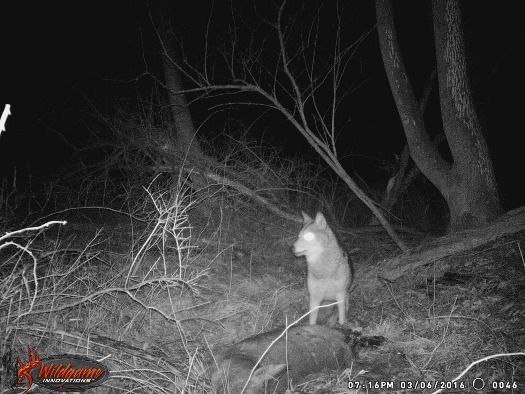
The coyote stuck around for only a few minutes on this first visit, but as soon as the coyote was finished with its snack, a red fox stepped in for a meal (note the time on the photo below).
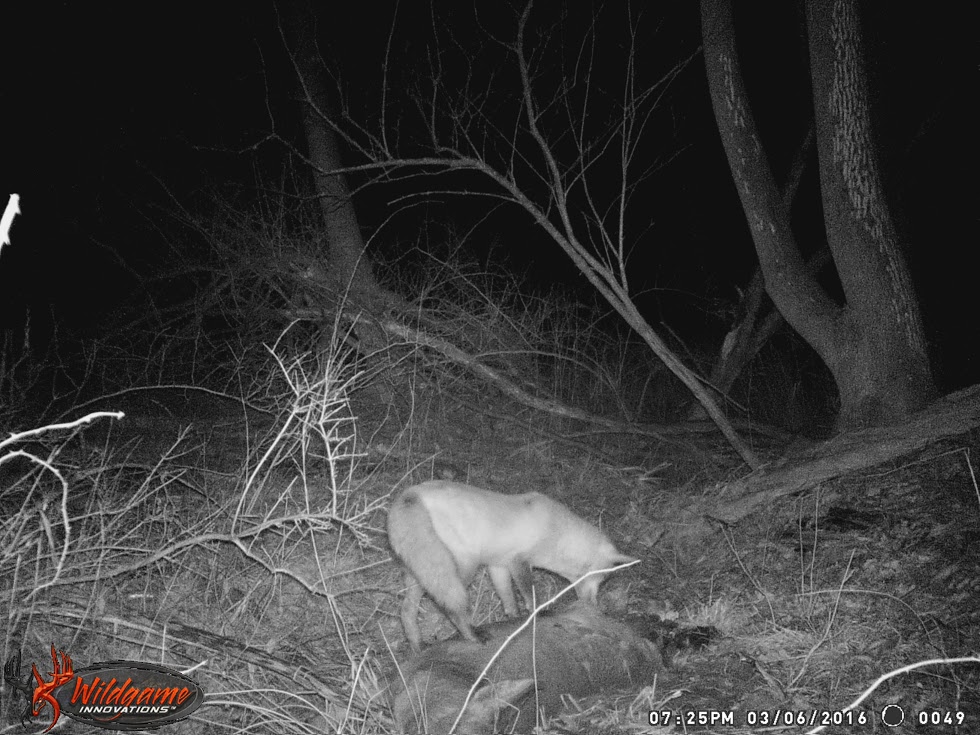
These smaller members of the canine family will also feed on a dead carcass, but their diet mainly consists of small mammals, birds, eggs and fruit. Fox enjoy the mix of habitats provided by suburban neighborhoods, so it is not unusual to encounter one at twilight at Reinstein Woods or to spot one in the surrounding neighborhood.
Over the next couple of days, the camera captured several visits by coyote and red fox. Interestingly, in the early hours of March 9, a fox was enjoying a meal…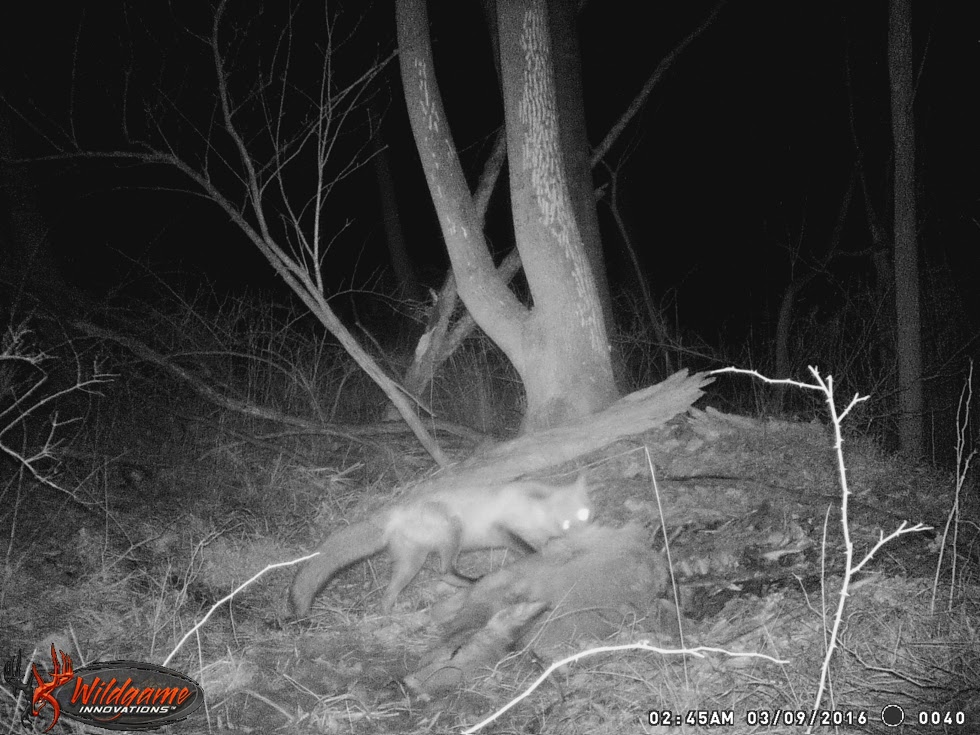
When it was interrupted by not one…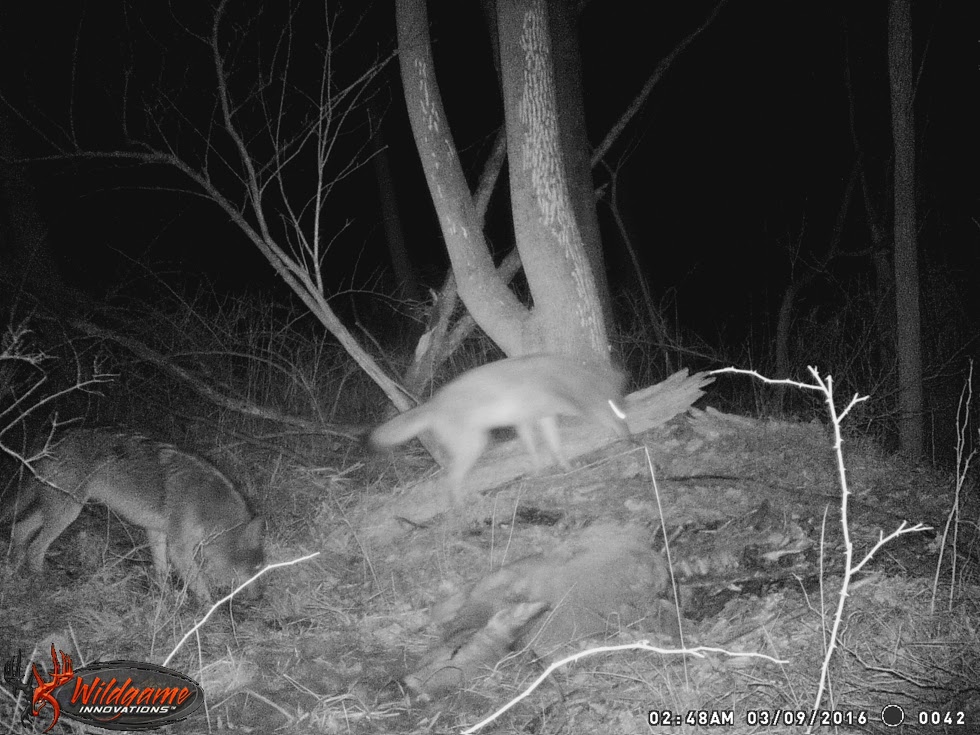
but two coyotes!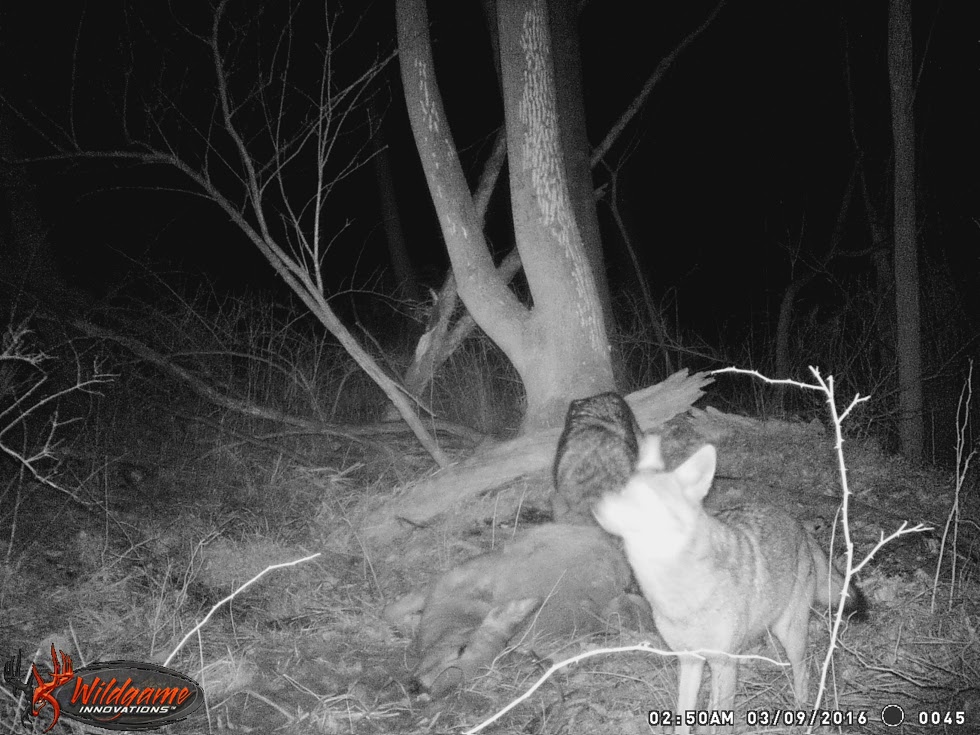
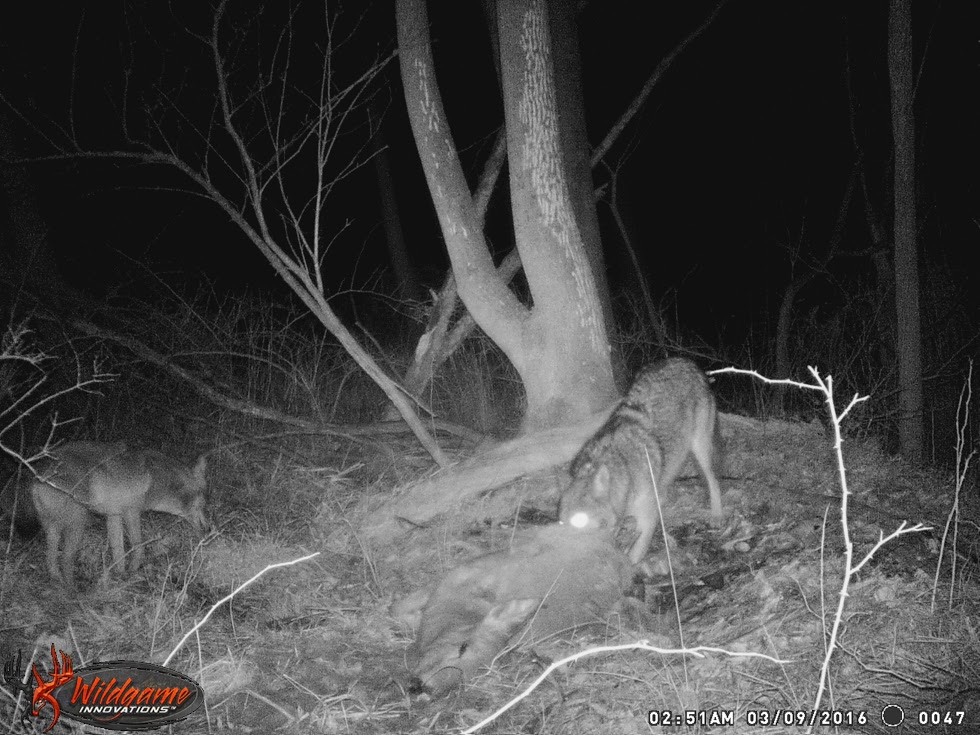
Reinstein Woods, Partners Celebrate “A Day in the Life of the Buffalo River”
In October, eight Western New York schools participated in the second annual “A Day in the Life of the Buffalo River” event.
With the help of DEC environmental educators, partners and volunteers, more than 150 students in grades 4-12 collected scientific data along the Buffalo River and its major tributaries, creating a “snapshot” of the watershed at one point in time. Students calculated current speed, measured water and air temperature, observed aquatic life, and investigated water chemistry and weather conditions.
“Providing hands-on experiences for students is something our organization strives to do,” said Friends President Michael Gettings. “This was a great opportunity for area students to connect with this important water resource while practicing skills used by real scientists.”
Many sites had a “river expert” from a partnering organization who shared their knowledge with the students. Partners included the Alliance for the Great Lakes, Buffalo Audubon Society, Buffalo Niagara Riverkeeper, DEC’s Division of Environmental Remediation, DEC’s Great Lakes program, and the U.S. Fish and Wildlife Service.
When asked about their favorite part of the day, one student said, “Being able to actually go in the river and scoop for fish and living things.”
More than half the students came from schools with underserved populations, and schools used this opportunity to enhance what students were already learning in the classroom. Additionally, high school students from Buffalo Public Schools’ International Preparatory School served as mentors to younger students participating at their site at Red Jacket Riverfront Park.
Friends of Reinstein Woods’ educator Brittany Rowan coordinates the program, working to educate teachers about the program ahead of time.
“This program was great! The staff was well trained and knowledgeable,” said Carol Clark, a teacher from St. Mary’s School for the Deaf. This was the first time that St. Mary’s participated in the program.
Data from all sites will be shared on a website built by SUNY Buffalo State College students so classes can compare their data with other participants and previous year’s results.
Garlic Mustard Challenge Winners Announced
On Saturday June 14 at Beaver Meadow Audubon Center, Reinstein Woods’ Cara Politi announced the winners for the fourth annual Garlic Mustard Challenge. More than 300 volunteers removed 5,100 pounds of the invasive garlic mustard plant from three nature preserves in Western New York, improving hundreds of acres of habitat! The Challenge is a joint effort of Friends of Reinstein Woods, NYSDEC’s Reinstein Woods Environmental Education Center, Buffalo Audubon Society and the Western New York Land Conservancy.
To increase their impact , 17 volunteers also removed garlic mustard at the Lewiston Plateau Habitat Area in Lewiston, Niagara County, during a one-day “Super Pull.” Volunteers pulled 277 pounds of garlic mustard in just three hours.
Beaver Meadow Audubon Center claims bragging rights as “Challenge Champion” for harnessing the most volunteer power (pounds of garlic mustard per person) of the three nature preserves. The organization’s 52 volunteers pulled more than 2,394 pounds of garlic mustard!
Thank you to all of the volunteers who participated in the Challenge!
Garlic Mustard Challenge Winners
Reinstein Woods:
First Place: Riptide Plus, Buffalo (168.75 pounds)
Runner Up: Pack 592, Orchard Park (123.75 pounds)
Beaver Meadow Audubon Center (North Java):
First Place: Olivia’s Mustard, Lancaster (1,113 pounds)
Runner Up: East Pembroke Grange, Pembroke (769 pounds)
Kenneglenn Preserve:
First Place: Boy Scout Troop 513, East Aurora (1,016) pounds)
Runner Up: Cub Scout Pack 514, East Aurora (348 pounds)
Lewiston Plateau Habitat Area ‘Super Pull”:
First Place: Unicorn Troop, Kenmore (151.5 pounds)
Runner Up: Daemen YALT, Daemen College (55 pounds)

